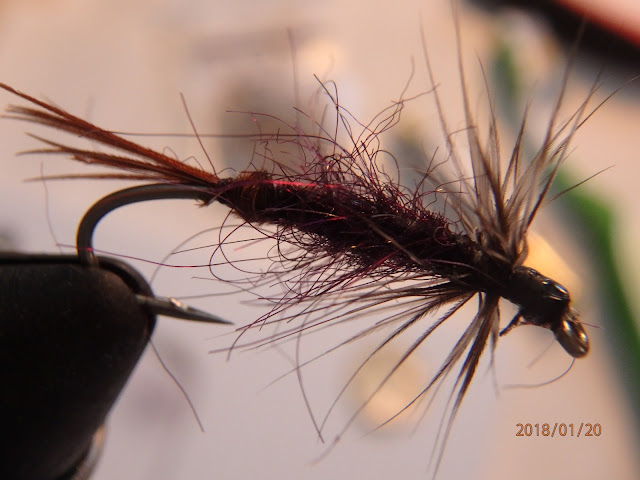Recipe:
Size: 10 3xl heavy hook. Shown is Umpqua U205.
Thread: black or claret.
Tail: 5 or 6 fibers from pheasant cock tail. (I do tie with hen tail feathers so the distinction matters.)
Abdomen: pheasant fibers wrapped.
Thorax: Wotton SLF in dark claret wound in a dubbing loop (improves durability) tied in exaggerated in length.
Soft Hackle: barred, black, brown, or dun prepared, stripped to only 1/2 the barbs on one side, wrapped 3 turns. Tied tip-in.
Head: thread substantially wound indicating distinct nymph segment between soft hackle and hook eye.
Information on the nymph.
Isonychia collectively represents an entire genus of mayflies.
The iso genus has several sub-species. In common names:
- the Slate Drake (bi-color iso nymph),
- the White-Gloved Howdy,
- the Lead Winged Coachmen (yes, just like the classic fly pattern),
- and the Mahogany Drake.
I make great generalizations here across all the species because they all behave the same. It really isn't too important to know one from another.
The color is a bit lost on me though Ann Miller says he is reddish-brown to purplish-brown in body. Sounds good.
The iso is active in the fastest parts of streams. He is a great swimmer dashing from rock to rock within his habitat.
He perches on rocks in the mainstream or just off it with his back legs gripping tightly while his foreparts and forelegs make a basket from which he catches and consumes bits and pieces.
He's in the water actively from May through September in one form or another and crawls to the slower water on the stream's side to emerge.
He's a dark beastie in the water 12 - 17 mm long. He's longer than your thumbnail, then. Orvis sells an articulated imitation which gives you an idea of the substantial length of the nymph. ( I'd don't find tying two-piece flies fun and I can't imagine anyone else does either).
He lives on rocks, in gravel beds (usually with larger rocks interspersed), and on small boulders just like the ones you think should shelter a big brown. He's in the mainstream in the swift well-oxygenated water.
Trout see displaced iso nymphs all year long. He lives in large populations on stretches of Michigan rivers like the Au Sable.
Most hatches occur in the late afternoon towards evening. Iso migrate to the slower side-water to crawl out on rocks prior to a hatch. Fish will follow the herd so if you suspect drakes are hatching but you see no surface feeding by the trout, swing slowly through the water for the fish feeding on the bottom.
A note on the duns: they take several seconds to emerge and can be quite clumsy. I've not seen mid-stream emergers myself though the is some indication of it anecdotally in the literature. Iso favor coarse-textured rock for crawling out.
The fishing is simple: bottom 1/3 of the water column.
I like a tight-line swing delivered thirty degrees upstream with small jerky tugs of 1-2" as the swing progresses and I know I'm at depth. It helps the hook-ups and helps the imitation as isonychia do have a jerky style of swimming.
I use other means to get the fly down to that bottom level rather than weighting the nymph. I want the nymph to float free as if lost in the current rather than thump along at the bottom mixed in with the bits of organic detritus. The hackle provides an illusion of life differentiating our flymph from the other small stick-like organic detritus in the drift.
References:
Hatch Guide for Upper Midwest Streams. Ann Miller. pp 116 - 121.
Nymphs. Ernest Schweibert. pp. 204 - 210. (In my 2nd edition with all the corrections).
Mayflies: An Angler's Study of Trout Water Ephemeroptera. Malcolm Knopp and Robert Cormier. pp. 84 - 91.

No comments:
Post a Comment